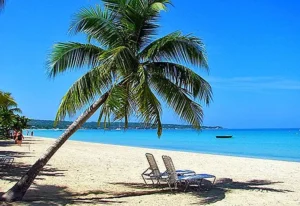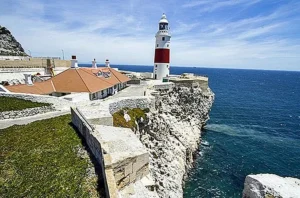Home to Morocco’s main international airport, Casablanca is the main gateway to the country for many visitors and often their first introduction to the country. This city is an industrial and business powerhouse, and compared to the exotic charms of Marrakech and Fes, it can’t compete. There’s a European flavor to much of its architecture, and the city has a modern swagger unseen in other parts of the country.
Although Casablanca’s tourist sights and attractions aren’t as obvious as those elsewhere, if you dig a little deeper you’ll find some gems. The medina district is a charming area and much smaller (and easier to navigate) than those elsewhere. And the colossal Hassan II Mosque tops the list on most sightseeing checklists.
Read also: Top-Rated Tourist Attractions in Rabat
1 Hassan II Mosque
On the coastline, just beyond the northern tip of Casablanca’s medina (old town), the Hassan II Mosque dominates the entire city. Completed in 1993, it is the second largest mosque in the world, covering an area of two hectares with the world’s tallest minaret (200 meters high). The prayer hall can accommodate 25,000 worshippers, while the courtyard (with a retractable roof) can hold another 80,000. Amazingly intricate decoration covers every inch of the surface. The location, right at the tip of the rocky bay above the ocean, is dramatic. Non-Muslims can visit the mosque on guided tours, which begin several times a day at the mosque’s western entrance.
Address: Boulevard Sidi Mohammed bin Abdullah
2 Medina

Medina
Although Casablanca’s old town doesn’t have as much of an exotic atmosphere as the medinas of Fes and Marrakech, its maze-like bubble of alleys still hides plenty to discover. Authentic traders sell their wares to shoppers, with the butcher, baker and candlestick all responsible. It’s a sprawling and run-down neighborhood with an authentic residential feel and a great place to experience the heartbeat of Casablanca life. There are also some interesting holy men koubbas (shrines) in the southern part of the medina.
Location: main entrance of Place des Nations Unies
3 Place Mohamed V

Place Mohamed V is the central square of Casablanca. It is home to many of the city’s most important official buildings, including the main post office, the Palace of Justice, the prefecture, the French consulate and Morocco’s main bank. The building’s facades all display the neo-Moorish style that French resident General Lyautey planned for the city when he began modernizing Casablanca at the beginning of the 20th century. The square has a central fountain and well-maintained gardens. In the evening it is a local favorite place to stroll.
Address: Avenue Hassan II
4 Corniche

Casablanca’s Corniche (beach neighborhood), in the suburb of Ain Diab, is the city’s vortex for those who want to see and be seen. Much of the coastline is now home to luxury hotels and restaurants. During the day, the many beach clubs here do a bustling trade with sun worshipers reeling in rays and splashing in the club pools. Further along the coastline is the public beach. On sunny weekends this is a great place for people watching, with plenty of local families heading to the sand for picnics and promenades.
Address: Boulevard de la Corniche, Ain Diab
5 Cathedral of Sacre Coeur

This graceful cathedral was built in the 1930s, and its architecture is a harmonious blend of both European and Moroccan styles. Sadly, it has been left to wither in recent decades and is now in serious need of restoration. But even in its current dilapidated state, the structure is still beautiful. If you’re lucky, the guardian will let you inside where you can get a sense of the past glory of this building. Nearby is Notre Dame de Lourdes , a church illuminated by a large stained glass window of more than 800 square meters.
Address: Boulevard Rachid
6 Central Market

Casablanca’s bustling Central Market is a must for tourists who want to immerse themselves in the heart of city life. Right in the city center is the market where locals come to buy and sell – whether they are housewives bartering for vegetables or grocers shouting out their special deals. It’s a great opportunity for photographers and fun for everyone. You’ll find everything from plastic bowls to Morocco’s famous slippers here. You never know, you might be able to snag a few bargains for yourself during the visit.
Address: Rue Allal Ben Abdullah
7 Mohammedia

Mohammedia
This sleepy seaside city offers a few more beaches , and is a relaxing alternative to a stay in Casablanca. Although it is home to Morocco’s second largest port, Mohammedia and its quiet charms have not been tarnished by industry. The Little Medina is a pleasure to wander through, while the New Town area is attractively laid out, with large palm tree-lined boulevards. On the coast it’s all about the beach. Cafes and restaurants here bustle with activity during summer weekends, when half of Casablanca seems to escape to the sands of Mohammedia.
Location: 28 kilometers north of Casablanca
8 Clean

Safi has been an important port since Roman times, but it was the Almohade rulers who surrounded the city with grand ramparts and turned it into an intellectual and spiritual center. The Portuguese occupied the city in 1508 and added to its architecture by building the stately building Dar el Bahar Fort on the coastline – now the city’s most recognizable monument. Safi is Morocco’s most famous ceramics center and once you’ve visited the fortress, Safi’s medina is a great place to spend an afternoon. Pottery Souk and the National Ceramics Museum are the star attractions of the old town.
Location: 237 kilometers south of Casablanca
9 oualidia

oualidia
This charming seaside village has a laid-back atmosphere that’s perfect if you’re exhausted after visiting Morocco’s imperial cities. The lovely beach and Saadian-era Kasbah (fortress district) are reason enough for a trip here, but for many others Oualidia is all about the oysters. The oyster beds of Oualidia are famous throughout the country. Local restaurant menus feature oysters and a host of other seafood pulled fresh from the sea that day, making the city a highlight for any traveling foodie.
Location: 182 kilometers south of Casablanca
10 Azemmour

When the tourist boards started promoting Morocco’s Atlantic coastline, they somehow left little Azemmour off the list. But this village has a history dating back to Punic times, and a wonderful handful of sites demonstrate that long tenure. The adobe ramparts surrounding the medina area are an obvious attraction and connecting them to the Kasbah (fortress) dates back to the 16th century.
The beach is also one of the best along the Atlantic coast – and is a well-kept secret. Indeed, half of Azemmour’s charm lies in the fact that no one else seems to stop here.
Location: 88 kilometers south of Casablanca
11 El Jadida

El Jadida
For a small town, El Jadida is packed with interesting things to do and is surrounded by beautiful stretches of sand, perfect for flopping around when you’re done with history. In the Citadel area, built by the Portuguese, you can clamber up the walls for stunning sea views and then visit the old prison , which also once functioned as the city’s synagogue. Also in the citadel area, see the atmospheric cisterns , which date back to the 16th century and were used as a filming location in Othello, Orson Welles’s famous film.
Location: 102 kilometers south of Casablanca
History
Casablanca’s origins can be traced back to the medieval town of Anfa, which is now one of the city’s suburbs. Anfa became the capital of a Berber principality in the aftermath of the Arab invasions of the 7th and 8th centuries. The Berbers embraced Islam but quickly succumbed to heretical doctrines, setting up their own prophet and a Quran in Berber language.
The principality was known as Berghouata and its tribal inhabitants led a Kharijite rebellion against the Arab governor of Tangier. In the 11th century, the Almoravids waged a holy war against these heretics, who were eventually defeated by the Almohad Sultan Abdul Mou’min. The city came under the influence of the Merenids in the 13th century, but eventually became independent as the dynasty weakened. The Portuguese destroyed the city in 1468 in retaliation for piracy. Portugal sent a fleet of 50 ships and 10,000 soldiers to occupy the city, which was sacked and then abandoned. But piracy soon revived and the Portuguese returned in 1515 and destroyed the city again.
In 1575, the city was rebuilt, fortified and renamed Casa Branca by the Portuguese in an attempt to establish control over the area. However, the Portuguese rulers fell under constant attacks by surrounding Muslim tribes and were eventually forced to abandon the city after a terrible earthquake in 1755. Under the reign of Sidi Mohamed ben Abdallah (1757-1790), the city was rebuilt with a mosque, madrasa, hammam and a fortress and renamed Dar El Beida (The White House), which the Spanish eventually translated as Casablanca.
Where to stay in Casablanca for sightseeing
To enjoy the modern atmosphere and historic sights of Casablanca, the best place to stay is in the city center, near the old medina, which is about a five-minute taxi ride from the Hassan II Mosque. Another popular place to stay is on the coast, especially in the chic Anfa district, just off the Corniche. From here it is less than 10 minutes by taxi to the city center. Below are some highly rated hotels in these convenient locations:
- Luxury Hotels: The Sofitel Casablanca Tour Blanche is located about two kilometers from the Hassan II Mosque and within walking distance of the old medina. It has a spa and heated indoor pool and is popular for its friendly staff and chic, bejeweled rooms. Breakfast is included in the price. Located a few steps from Place Mohamed V, the Boutique Hotel & Spa Le Doge is housed in a large Art Deco villa, offering glamorous rooms, delicious food and attentive service. If you prefer to stay in an oceanfront resort, the Four Seasons Hotel Casablanca exudes contemporary Moroccan elegance. Facilities include a spa and outdoor pool and jacuzzi with private cabanas.
- Mid-Range Hotels: Right next door to the Four Seasons, oceanfront Pestana Casablanca is a great option for families or longer stays with its apartment-style accommodations. The pet-friendly Kenzi Tower Hotel is located in the city center, a short drive from the Old Medina and less than three kilometers from the Hassan II Mosque. It offers great city views from top-floor rooms and the hotel offers free parking, a swimming pool and fitness centre. The Kenzi Basma, also popular in the center of the region, is within walking distance of the old medina.
- Budget Hotels: Ibis Casablanca City Center , with simple, modern rooms opposite the Casa-Port train station and with easy access to the old medina. The Al Walid Hotel is right opposite the Casa Voyageurs train station and about two kilometers from the central market. It has clean, modern rooms with free Wi-Fi. The nearby Ibis Casa Voyageurs is another affordable option close to public transport in the city center.
Read also:
Highly Rated Tourist Attractions in the High Atlas Region of Morocco





